Two months in rural Japan with an obsessive young barman trying to reverse the fortunes of his country’s national beverage.
Halfway into my two-month apprenticeship at Engawa sake bar in a rural hot spring town in Japan, my sensei invites me to join him for his daily ritual. I follow him outside to a mountainside shrine. As we climb the moss-covered stairs, he instructs me to observe the plants, the temperature, and the feeling of the season, so we can determine what kind of sake the day calls for. He teaches me to pray at the shrine, and then he tenderly brushes away some fallen leaves and places several coins, asking the spirits to bring him good business.
Behind the counter of his tiny bar in the mountains of Ishikawa, on the Sea of Japan coast, Yusuke Shimoki is trying to save the Japanese sake industry, which has been in decline since peak consumption in the 1970s. Shimoki is not the wizened old man you might expect to find in such a place. At 31 years old, he has the aspect of a very serious teddy bear, with a slight potbelly from spending more than 16 hours a day tasting, contemplating, and serving sake, and bright eyes that light up when he talks about it. He is a missionary for sake.
A neighbor remarks that she has never seen him without his uniform—white shirt, black pants, vest, and tie—even at the supermarket, or running errands around town. His hairstyle, though always slicked back with a handful of gel, is surprisingly contemporary: shaved close on the sides and long in the middle. (On his one day off he allows it to flop to the side boyishly). His eyebrows, neatly shaped into high arches like the men in Japanese fashion magazines, dance with delight when he talks about a favorite brewer and furrow when he contemplates the proper cup and serving temperature for a particular sake.
In Yamanaka Onsen, where I’m studying with Shimoki, you can find the version of Japan that we idealize in the West. Misty ridges encircle ancient wooden houses and weathered shrines. The smell of cedar and sake permeates the air. Generations of craftspeople and farmers carry on centuries-old traditions, making tableware by hand and cultivating rice.
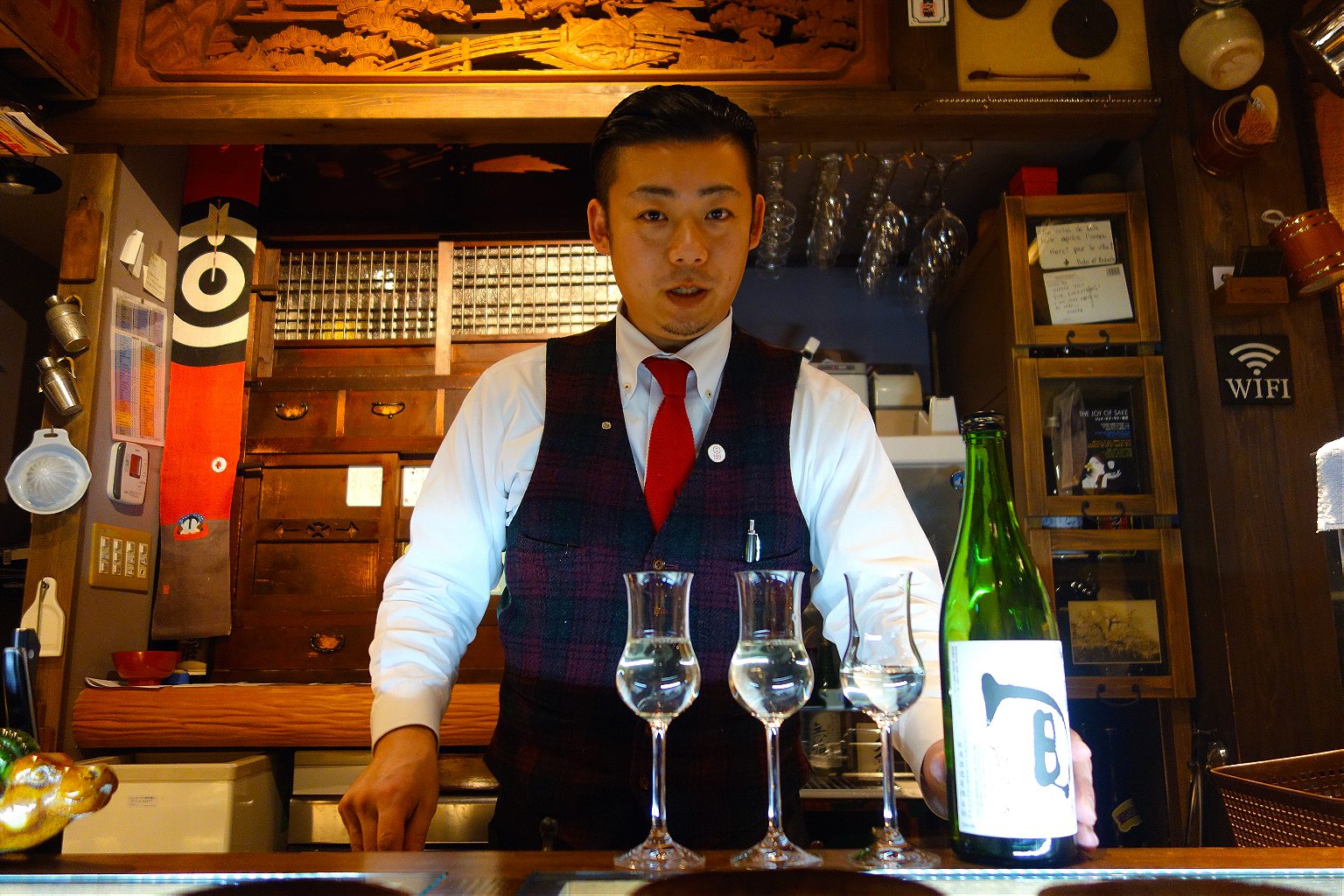
Shimoki is eager to connect with the wider world, both to evangelize for sake and to broaden his own horizons (or at least his ideas about tasting and serving drinks). A mutual friend asked me to host him in Brooklyn for five days last summer, and we first met when he arrived at my doorstep. He had never left Japan before. Besides having lunch at the famous Peter Luger steakhouse, everything he did in New York revolved around sake—seeing how it’s sold, served, and enjoyed in the U.S. (I had to insist he eat pizza for his last meal in New York.) While Japanese people are adopting more Western customs and drinking less sake, the Western world is embracing Japanese cuisine, and drinking more and more sake. Many people, including Shimoki, believe foreign acceptance may be the promising future of this declining industry.
He may have been joking when he first offered me an apprenticeship at Engawa, but it quickly became a real plan. I’d been waiting for the right opportunity to immerse myself in Japanese language and culture while doing work that’s relevant to my career as a food writer and stylist, as opposed to just teaching English. That’s how I found myself in a part of Japan that few foreigners visit, much less live.
The town of 7,000 people is just accessible enough to benefit from tourism, but isolated enough not to be spoiled by it. Most visitors come from other parts of Japan. Natural hot springs, a meandering stone path along the Kakusenkei Gorge, and a couple of 2000-year-old cedar trees at the edge of town are the main attractions. From Tokyo it takes three to fours hours on two trains to get to the nearest station at Kaga Onsen, six miles away.
The road from Kaga Onsen quickly leaves behind the pachinko parlors and chain stores around the train station, passing through farmland and small villages flanked by a curtain of mountains, the most spectacular of which is snowcapped Hakusan. The temperature drops noticeably and rice paddies give way to cedar forest as the road climbs toward Yamanaka Onsen. Its downtown is situated in a narrow valley beside the Daishoji River, and you can walk it from end to end in less than 20 minutes.
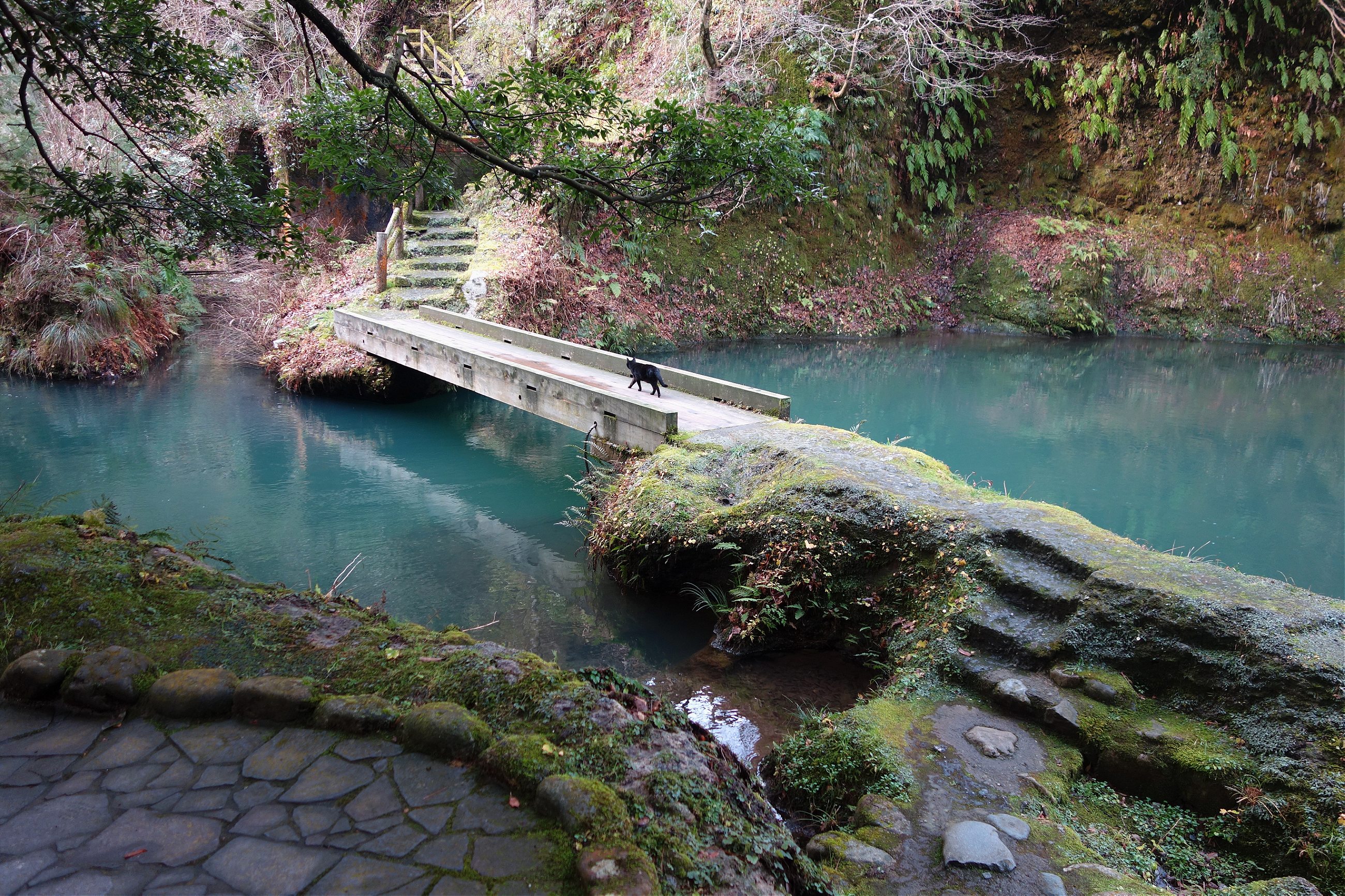
Dilapidated high-rise hotels along the riverside are evidence of a seventies hotel boom and the lasting depression that followed. Even the nicest buildings in Yamanaka are in a perpetual state of decay from the moist climate. But it’s easy to become entranced by the icy blue river and bright red maple leaves falling softly on mossy rocks and all but ignore the shabby facades on the opposite bank as you walk the gorge.
Engawa is at the top of a small side street towards the end of town, just before the main road heads deeper into the mountains. Where the side street ends at the entrance of Hasebe Shrine (where Shimoki observes his daily ritual) there’s the bar, with its warm light flowing into the damp darkness.
It’s early December, and we can feel the cold pressing in as we return from that visit to the shrine. Tonight people will want to drink kanzake, poured hot from a small iron kettle, at precisely 55 degrees. In the U.S., heat is deployed to disguise the flavor of cheap swill. But in Japan, heating sake is an art. Next to the counter Shimoki displays a chart showing how intervals of just a few degrees highlight different flavors. By now, a month in, I’m familiar with the concept: On a few occasions he’s served me five or six cups with the same sake heated incrementally warmer in each. At 55 degrees a robust sake burns pleasantly going down, warming you to the core.
It’s usually around their second drink when a guest notices that the music playing in Engawa is Scottish. It blends with the old wood and stone, and it matches Shimoki’s plaid wool vest. He explains that there’s music for beer and there’s music for wine, but there’s no music for sake. The music he hears in other sake bars is too dour. And while Shimoki himself is almost comically serious, the experience of being in his bar is relaxed and casual.
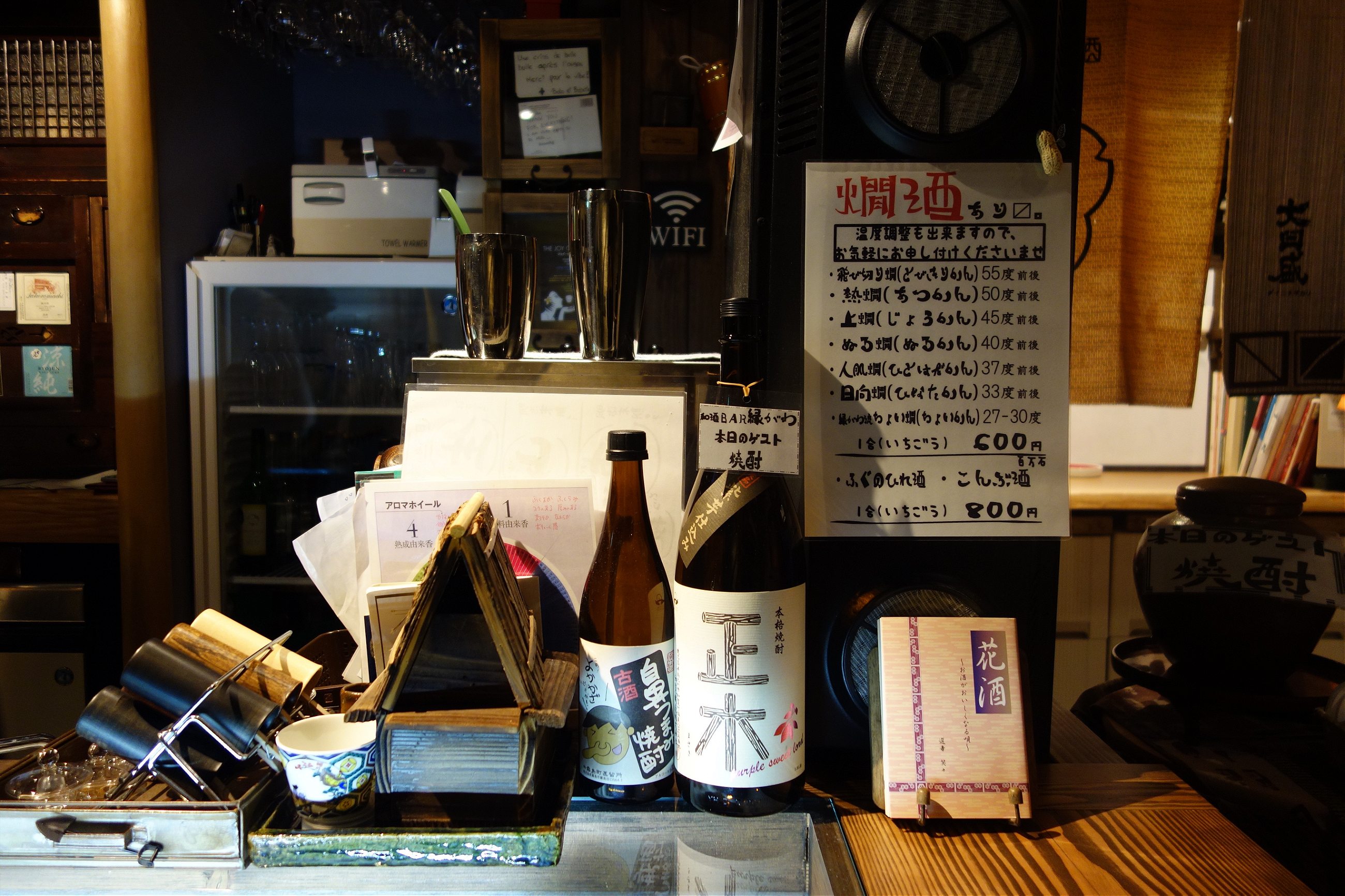
On any given night Engawa draws a mix of onsen-going tourists and sake connoisseurs who’ve pilgrimaged to Yamanaka, and locals at the end of their workday. There’s likely to be a master craftsman or a few students from the woodturning school (the town is famous for its unique style of cups and bowls); perhaps a government official or important guest from one of the fancy hotels. A couple of Shimoki’s childhood friends will probably come in later after their soccer game or shift at the crab restaurant. Once a week, my 81-year-old neighbor sits at the bar and drinks a sake, a whiskey, and a beer. If there’s a guest all the way from Tokyo or Osaka, Shimoki dotes on them. Whoever is there, it doesn’t take long before they are all talking and tasting one another’s drinks.
Engawa is a name for a kind of Japanese porch: a place to relax, drink tea and catch up with your neighbors. An older, literal translation of the characters means a place where two things meet, the border between one thing and another. That’s how Shimoki sees his bar.
Besides the five bar stools there’s a private room, painted Kanazawa blue, with a sliding paper door, which cozily accommodates four people. It’s frequently occupied by a middle-aged doctor and one of his young nurses, or by men in suits with the air of good-ol-boys (who call me in to entertain them by answering questions about what a lady from New York is doing in Japan), though sometimes by a family whose toddler daughter uses the same delicate water glass and expensive lacquerware chopsticks as all the other guests. In the narrow space that divides the bar from the private room and bathroom, round stone pavers are set into swirls of black and white gravel. Drunk young ladies in stilettos teeter over them precariously.
Shimoki is used to doing everything himself, and I feel like I get in the way more than I help. He seems glad to have me there, but I wonder what’s in it for him. He says he views me as his colleague, not his student. Still, I’m not sure he understands that my purpose here is broader than studying sake (maybe because of the language barrier, or maybe because it’s what he cares most about). On days when he’s too busy to teach me, I feel like the new panda bear at the zoo: People come to ogle at the novelty foreigner, and my job is simply to entertain them with my presence. The few times a Western tourist comes in, I help them understand what Shimoki has to offer.
But you don’t need to speak Japanese to understand when Shimoki describes a drink. “Piri-piri,” he says to describe effervescence, wiggling his fingers near his mouth to express tingly little bubbles. He waves his arm in a grand downward motion, leveling off at the end and saying “loooooooong finish.” Dramatic hand gestures and enthusiastic use of onomatopoeia transcend language barriers. He bounces like a cartoon character, and his enthusiasm is contagious. If a guest asks for a recommendation, he sizes them up and directs the arc of their drinking like a DJ picking the perfect progression of songs.
One of his favorite tricks is to serve you the same sake in two distinctly shaped cups. It tastes dramatically different, even to the untrained palate. While a scientist might tell you it’s a simple matter of how much aroma reaches your nose, for Shimoki it’s magic. Each time he opens a new bottle, he thinks hard about how best to enhance its character. Our perception of sake’s flavors, even more so than wine’s, is primarily informed by smell, so the vessel you drink from significantly affects which notes come forward.
On one occasion, a couple from out of town is asking about a glossy maple cup they’re drinking from. It’s made by a local artisan. Shimoki pulls open drawers of the antique wooden cabinet behind the bar and brings out another style by a different craftsman… then another and another until the small bar is cluttered with a dozen cups, each with its own story, each capable of bringing out a distinct expression of a single sake. It will taste more umami, earthy, herbaceous, or floral, depending on the shape and material of the cup.
My first night of work at Engawa is the first time in my life I have to fasten the very top button of my shirt.
Shimoki designed the bar’s interior with his architect friend. Its ornamental carved wood panels, modern iron and wood chairs with red velvet cushions, and a framed indigo print on handmade paper were made by his peers. Under the glass countertop is a Zen garden of raked sand and carefully placed rocks. On a high shelf to the far left a small television plays old samurai movies on a continuous loop. In the back right corner there’s a tiny shrine just below the ceiling, with a vase of flowers and a cup of sake that Shimoki refreshes daily. Almost incongruously, a laminated sign for wifi is stuck to the backbar.
Six days a week he comes in at 11 a.m. to tidy and take care of paperwork, and opens around noon to accommodate the occasional afternoon guest. Sometime before 5 p.m. he’ll take a break to restock and visit the shrine. He will keep the bar open until the last guest leaves—sometimes midnight, sometimes 5 a.m. There are no employees; my apprenticeship here is out of novelty, not necessity.
Though I’ve tended bar in some very high-end places, my first night of work at Engawa is the first time in my life I have to fasten the very top button of my shirt. Shimoki loans me a tie and a long apron. I offer to wash dishes and roll up my sleeves to get started. No, he says, rolled up sleeves are for laborers. I try to explain that it’s a new shirt and the sleeves are too long. Don’t worry, he says. I notice as I’m washing and putting away a water glass that a chip on its rim has been smoothed over and repaired with a bit of gold leaf.
He shows me how to take a coat and hang it neatly facing the wall, and how to offer each guest a steaming washcloth called a oshibori in such a way that they can take it with one hand. Then he shows me where to stand and watch him, which is how he expects me to learn almost everything.
I’ve seen the same thing in high-end Tokyo cocktail bars, where smartly dressed understudies pour water and wipe the counter for years before mixing a single drink. And it was how Shimoki learned too. He spent a year in Kanazawa working temp jobs and going to a whiskey bar called Makurihanisshu every day, ordering two drinks and reading the Japanese translation of Michael Jackson’s canonical Malt Whiskey Companion, a guide to over 800 whiskeys. Then he moved to Tokyo and worked 18 months at Mondo cocktail bar. You can see flourishes of cocktail service in the way he presents sake.
In broken English and Japanese—with the help of Google translate, a sake textbook, and the experience of tasting together—Shimoki and I develop a shared vocabulary. We figure out words for bitterness vs. astringency, characteristics like tingly or smooth, the names of fruits and flowers, ideal serving temperature and alcohol content. We can’t talk about anything personal, but we can talk about sake.
Before I came here I could tell that one sake was sweeter, another more delicate, I could see that it was clear or cloudy, but pretty much sake just tasted like sake to me (some better than others). But a just week into my stay I could distinguish all sorts of subtleties and aromas of persimmon… kelp… pear… pine. We taste new sake together almost every day, and he’s always excited about my observations.
The differences among sake are subtle, in part because of the nature of Japanese food. A western dinner that’s paired with wine or beer is often comprised of a main dish and sides to match, so wine can have a strong character as long as it suits the meal. But on a typical Japanese table, there are many small dishes at once, and the sake needs to be pliant enough to complement all of them.
Shimoki proudly serves sake from the surrounding Ishikawa region and neighboring Fukui, with only the occasional bottle from elsewhere in Japan. I quickly fall in love with the fresh and unpasteurized ones that are too fragile to export, so you have to drink them here. There are old sakes too, so oxidized they smell like sherry and hold up to dark chocolate.
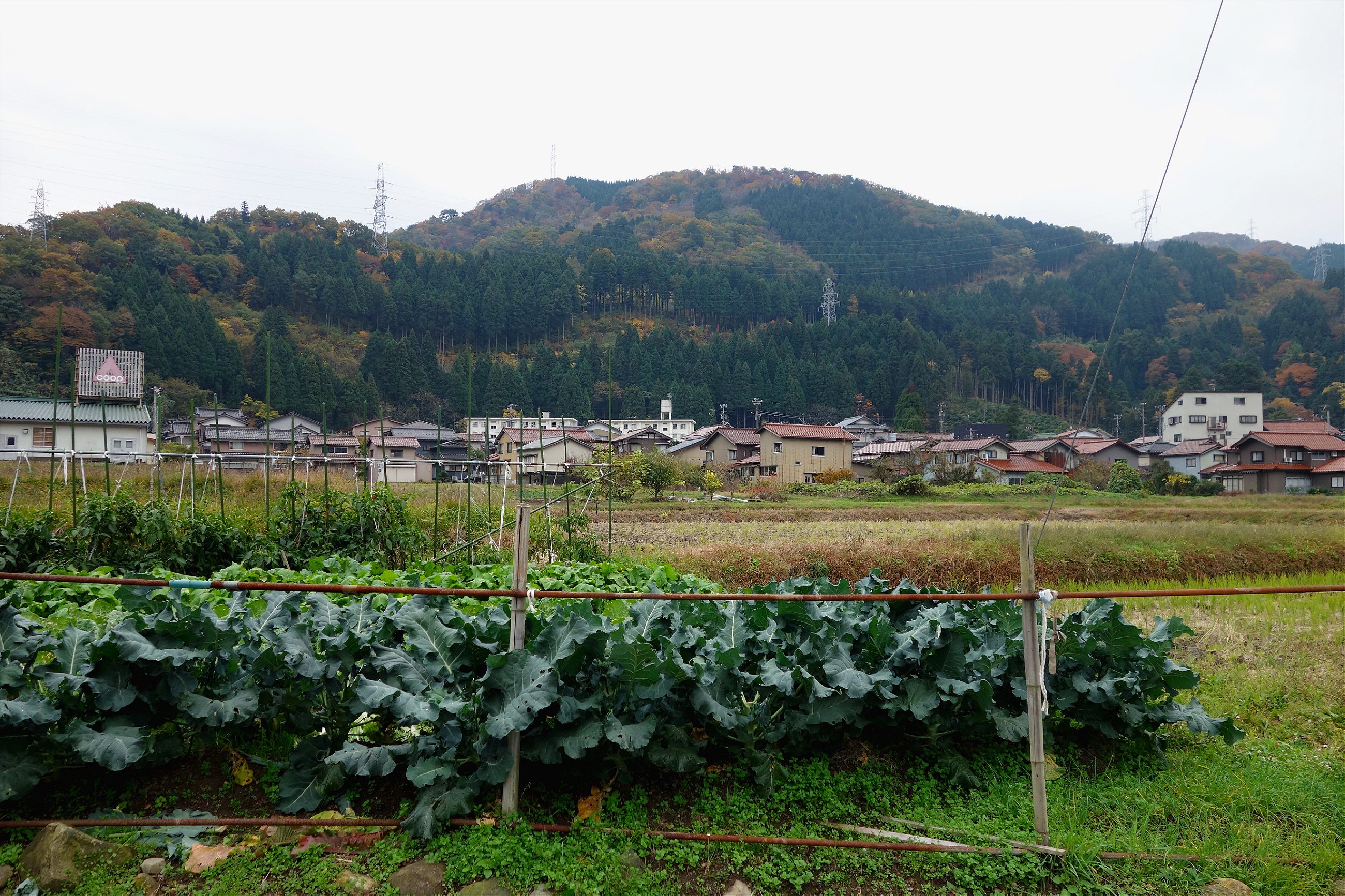
Every day, Shimoki prepares an assortment of otsumami, drinking snacks, using a tiny toaster oven, a torch, an induction burner, and a cutting board. There’s roast beef from the butcher up the street, which he heats and mounds on a plate, with a blanket of brown sauce and a handful of sliced scallion. There’s six-month-old miso-cured tofu that he cuts into tiny cubes and stacks neatly in a small ceramic dish. There’s tuna that he’s pickled in sake and soy sauce, which he sears with a torch before fanning out on a plate. And there are his famous soy sauce pickled egg yolks, which lately he serves spooned over slices of soft, fresh tofu. Or you can simply have a handful of deep fried soba noodles to snack on like potato chips, which he transfers from a big plastic jar to a beautifully turned wooden bowl. He also has chilled dark chocolate and yokan (a block of sweet jellied adzuki bean) that he slices, and arranges carefully on a mirror-like lacquered stand, dusting the chocolate with a snowfall of powdered sugar that he wipes into a crescent shape, and delicately placing bits of gold leaf on the yokan.
I’m sitting at the bar after my shift, having cast off my vest and tie. I ask Shimoki for tsukemono (Japanese fermented pickles), they’re my favorite. He brings me a long rectangular plate with three compartments: in the first, kyarabuki zuke (sake-pickled coltsfoot stem) made by the 81-year-old neighbor; in the second is umeboshi (pickled plum) made by his friend’s mother; and in the third a simple, okaka (bonito flakes mixed with soy). He pours an old-style sake—more austere and rough than the new fruity fresh brews targeted at wine lovers—into a cedar cup. Gesturing towards a pairing he’s served me, Shimoki says, “Japan.”
The pickles alone would be too salty without sake. The scent of the cedar would be too strong without the pucker of plum and pungent soy. The sake is softened by the wood. Together it’s poetry. He’s captured the essence of his country in a sake pairing.
In a town where your options are typically to take over the family business or leave for the big city (as evidenced by the aging population on a number of abandoned homes on the outskirts of town), Shimoki’s entrepreneurship is unusual.
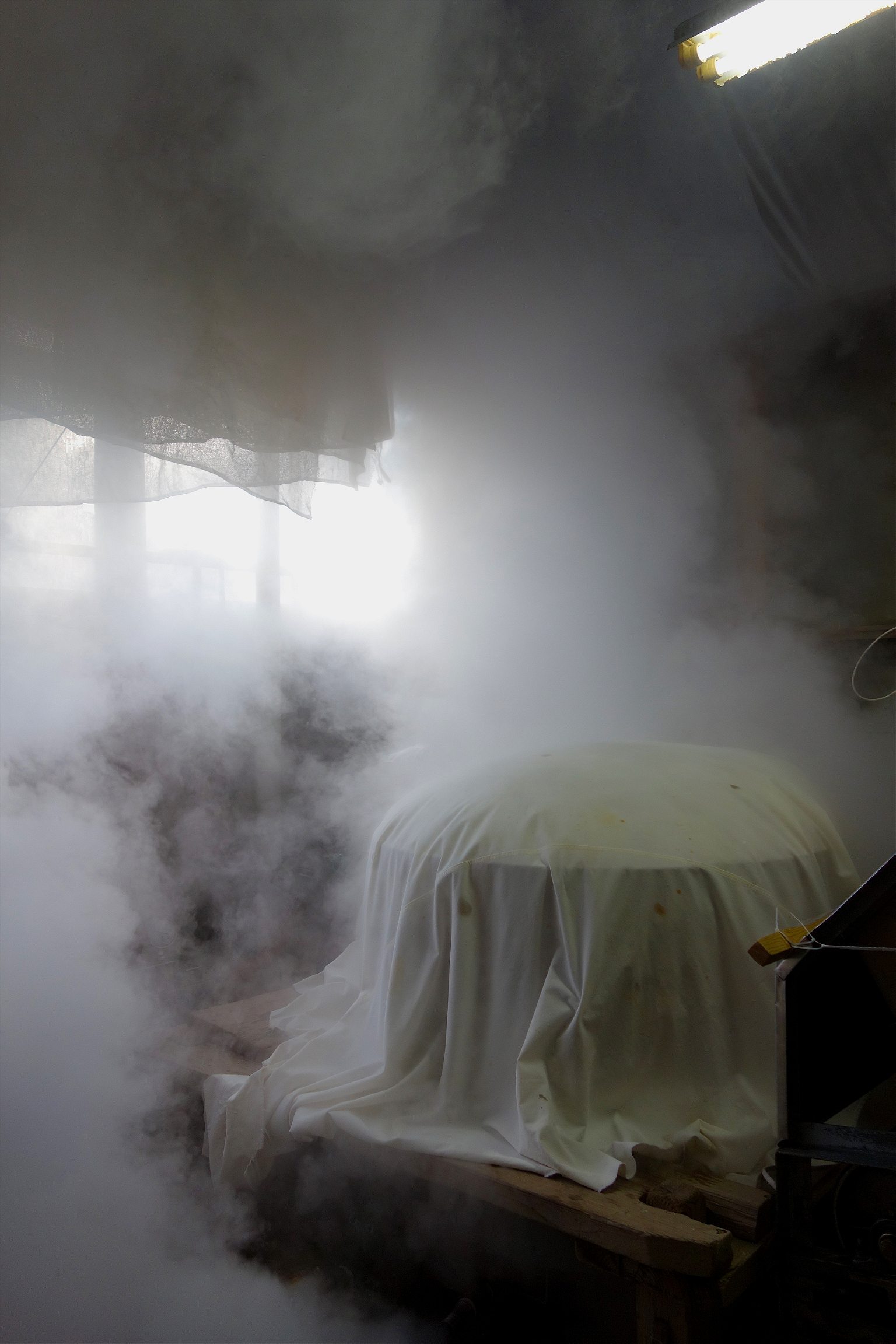
When he opened the bar on his 30th birthday in October 2014, he already had a reputation for his laser focus on Japanese spirits. Even before he earned his certificate for the Japanese equivalent of a master sommelier (an honor that less than 300 people hold), he worked in a local sake shop. The owner recounts with a chuckle the time she asked Shimoki to help out with a different job for the holidays, and he refused, saying it wouldn’t help him learn about sake. Neighbors speak of him with a combination of awe and bemusement, often calling him “little brother.” But when it comes to matters of sake, they defer to him.
Another friend, the white-tuxedoed proprietor of a jazz bar in the next town over, chuckles about Shimoki’s obsessive nature. You can have the best drinks in the world he says, but it doesn’t matter if people aren’t happy and comfortable. You have to think about hospitality. “Shimoki only thinks about sake!” He exclaims, with a mix of affection and exasperation. It’s to Shimoki’s advantage that hospitality, like nearly everything else in Japan, is codified. He can just follow the rules and focus on what he really cares about—sake.
On my rare nights off, Shimoki often texts me to come over and meet someone—a master craftsman, a sake brewer, or local government official. Tonight, it’s Matsuura, the master brewer at the sakagura called Shishi no Sato just up the street.
November and December are the busiest season for making sake. Small breweries like his aren’t temperature controlled, so they still follow a traditional calendar, brewing while the weather is cool so they can control the pace of fermentation, then aging the sake over the spring and summer. Tonight is his one night to drink beer and not think about sake before he has to babysit the bubbling tanks night and day for weeks at a time.
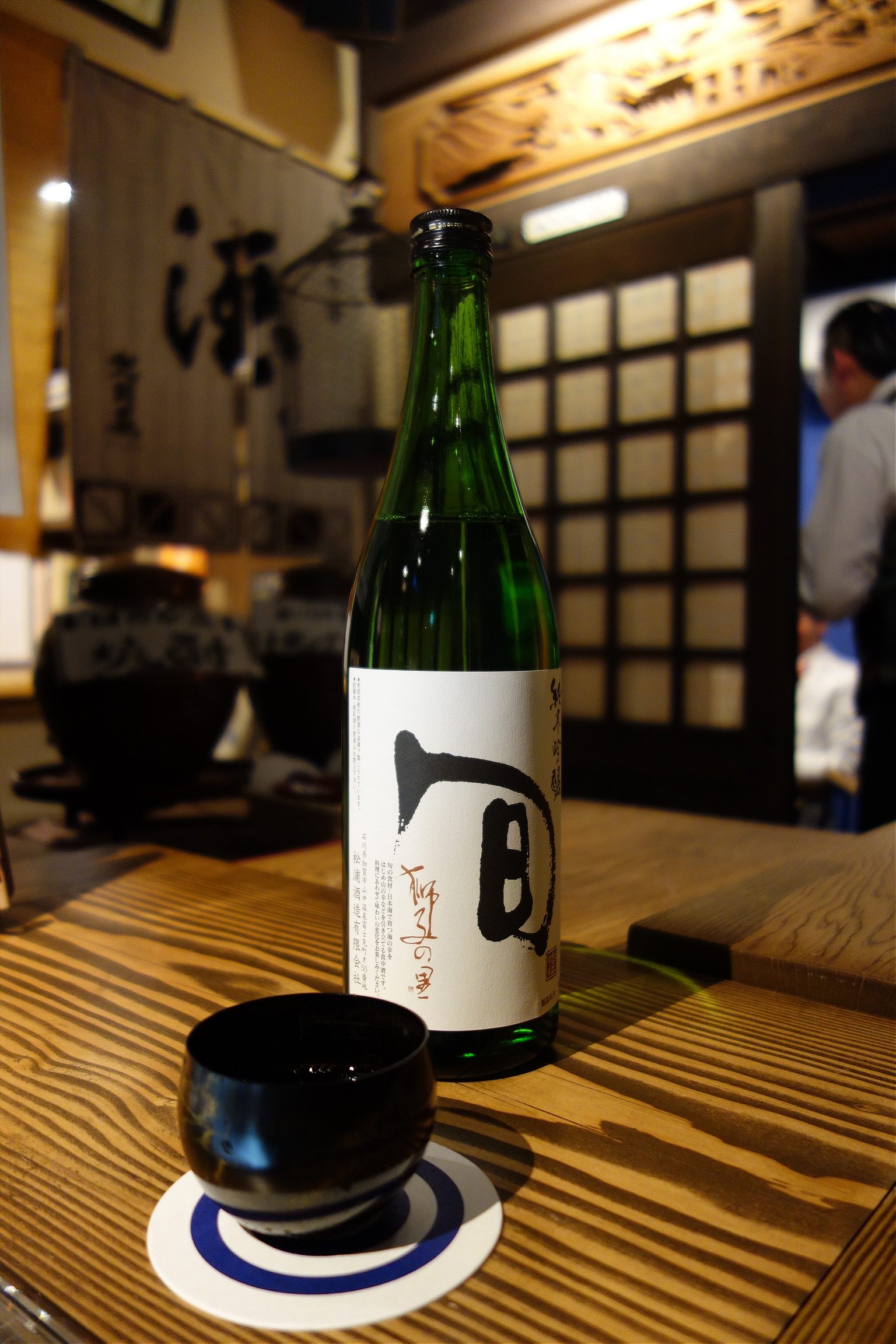
Shimoki wants me to ask Matsuura all my questions about sake and he pushes us together like an awkward couple on a blind date. In strained and careful English Matsuura patiently obliges. (I try to match him with equally bad Japanese). He shows me cell phone pictures of the portion of the rice that he grows himself each summer. He explains that Shun, my favorite sake, took years to perfect because he wanted it to be unassuming, not showy or complicated. It’s intended to drink easily, transforming to suit whatever food you want to eat. That balanced simplicity, the illusion of effortlessness, is the hardest thing to achieve. It’s clear though that Matsuura just wants to relax, and not think about the brewery tonight.
We escape Shimoki’s overeager encouragement, leaving with a couple of friends to eat midnight ramen and drink beer and highballs. By the time we all go home, Matsuura has promised I can visit his brewery. But he calls the bar in the morning to say he’s sorry, he was drunk, and he can’t have visitors. This happens once more before he agrees to give me a tour.
Weeks later, I finally get to visit Matsuura’s brewery. We have to be there at dawn. Matsuura called the bar the night before to ask us not to eat natto (fermented soybeans) or anything that might interfere with the sake’s fermentation. Shimoki also tells me I can’t drink coffee or tea because it might throw off Matsuura’s nose at the most critical time for testing the sake, so I arrive hungry and groggy. In his office, Matsuura asks us if we’ve had any natto for breakfast, and when I tell him I haven’t even had coffee he laughs a little and looks concerned. Coffee would have been fine.
At the threshold of the brewery, we’re given clean slippers and a baseball hat. In the morning light filtering through a blanket of steam, two men in white boots—one older and one younger—are washing and cooking polished rice in a high-tech caldron. The mash will be piped into a fermenting tank in the next room, where we follow Matsuura. We stand on a platform above a tank of what’s essentially rice porridge; from the floor above, the older man opens a hatch and dumps koji rice (inoculated with aspergillus oryzae mold) into the vat to start the fermentation. Later they’ll add carefully selected strains of yeast to convert the sugars (made available by the koji) into alcohol.
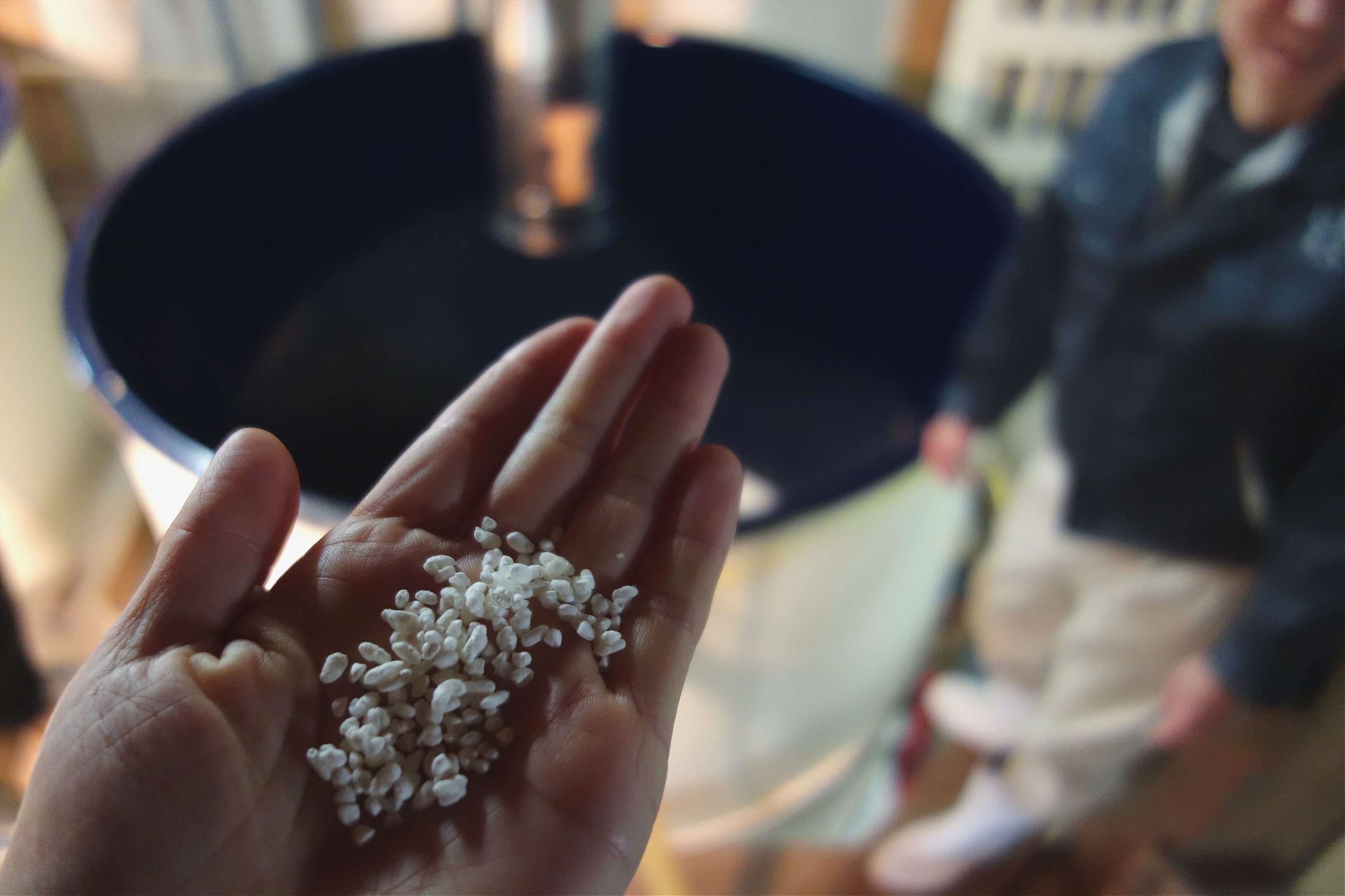
The next vat we visit is bubbling with yeast. Matsuura uses and older strain that make lots of foam—it’s an inefficient use of space, but it allows the yeast and koji to work in stratified layers, so the fermentation lasts longer and creates more complex flavors. Matsuuru uses a long ladle to scoop some sake from a vat that’s a little further along into cups for us to taste. Thick with bits of soft rice, it’s aromatic and sweet, and extraordinarily delicious. (Statistics may show declining sake consumption in Japan, but Matsuura has no trouble selling everything he makes. In fact, he has turned down offers to distribute his sake in the U.S., content with what he does here.)
At the Engawa that night, I chat across that bar with a friend about the best English translation for the soupy mixture of steamed rice and koji that begins the process of sake fermentation: Is it a malt or a mash? Not grasping the nuance of our conversation, Yusuke interjects. He’s very concerned that I know the difference between fermenting sake and fermenting beer or wine: it’s a parallel process where koji converts the rice into sugars, and yeast converts those sugars into alcohol. I assure him that yes, I read it in the textbook he gave me before I came; I understood what Matsuura was explaining; and I saw it with my own eyes. He still looks worried.
One evening, we’re discussing what would pair best with fresh young sake that tastes like pear and has a faint acidity. Suddenly it dawns on me that I am thinking about what food the sake would enhance, but he’s thinking about what food would enhance the sake. I share this with him and we both laugh at ourselves. For Shimoki, everything is about sake.
On a Thurdsay, Shimoki’s only day off, we are eating pizza with friends and I ask him if there’s a sake that would pair with pizza. Sake never pairs with cheese, he insists. Wine pairing is different, he explains. With wine, you look for contrast, but with sake the ideal match creates a “spiral taste” where the sake and food both enhance each other. You can achieve that with wine too, I counter. His friend agrees, but Shimoki is surprised. “I should study wine more,” he says, looking thoughtful.
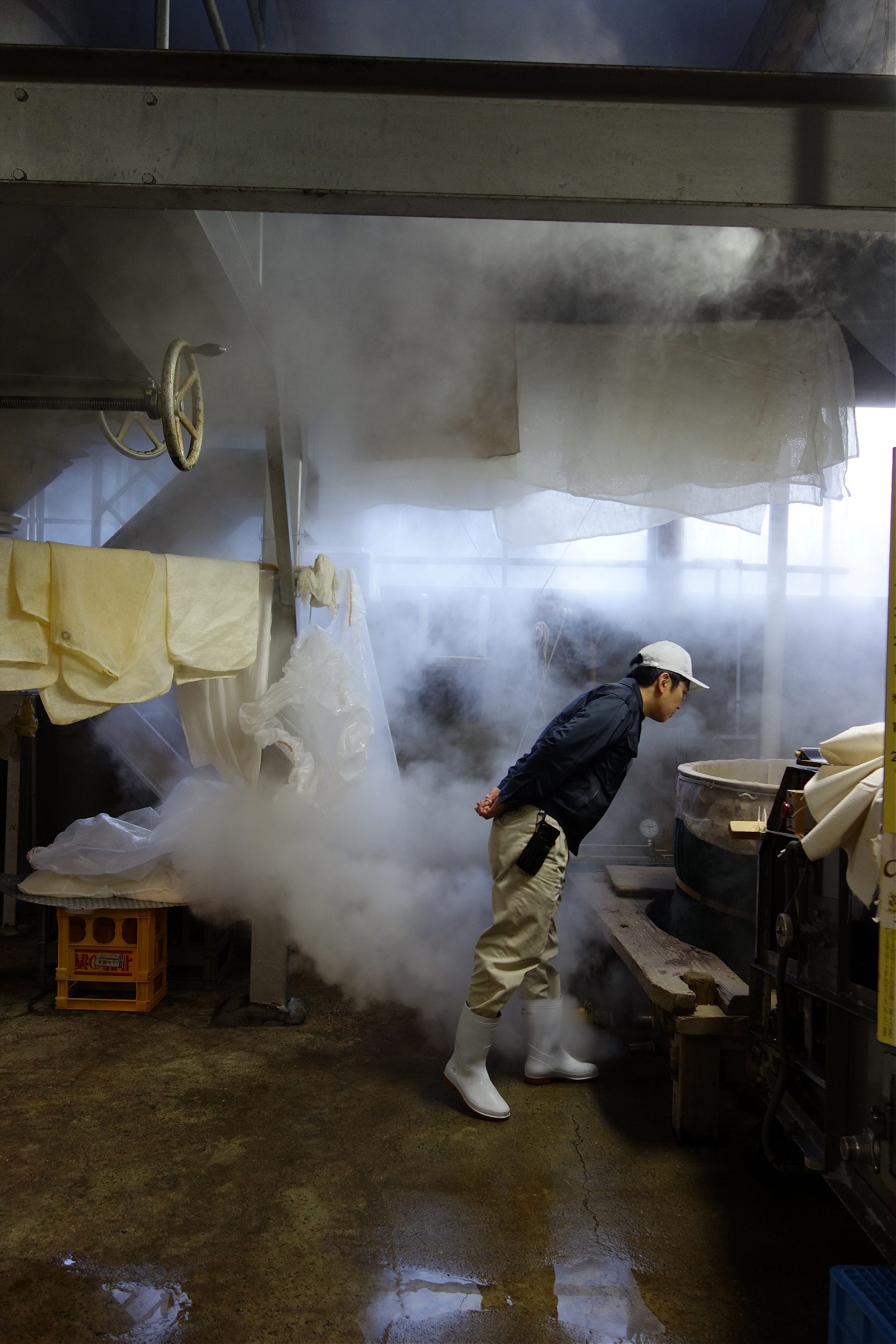
One person at a time, Shimoki makes converts. A 36-year-old cooking teacher from Kyoto, whom I bring to the bar one evening, confesses that it‘s the first time in her life she’s tasted sake. With her friends, she drinks beer or wine: it’s easier, more casual. She wouldn’t know how to pick a sake. But Shimoki gently and joyfully guides her, first pouring something from her hometown in Shikoku, reminiscent of the region’s famous oranges.
The very same young people that statistics would have you believe don’t consume sake fill up half the bar at Engawa most nights. Salarymen and hotel concierges, a couple of 20-year old aestheticians, couples on a romantic getaway—they drink cup after cup of whatever Shimoki recommends. Still, when I see some of the same girls at a Christmas party they are drinking beer and wine—and eating cheese. Without their master, the flock strays.
But Shimoki’s devotion is unshaken. I am his disciple, and I know he hopes I will bring his teachings back to New York with me. He is determined, up until the last moments of our time together to make sure he imparts as much as he can about sake, and about this corner of Japan that he loves so much.
One of the last times we taste together before I return to the U.S., he pours two new bottles of sake into tasting cups for me. The first blooms into the fragrance of a walk in the snow, with soft pine needles and the warmth of white rice cooking somewhere in the distance; a hint of umami from the sea; and a tingly finish that lingers. The second has a similar taste, but it burns going down, and the finish stops short. The difference, he says, is that the latter wasn’t made with feeling. “You have to have feeling.”